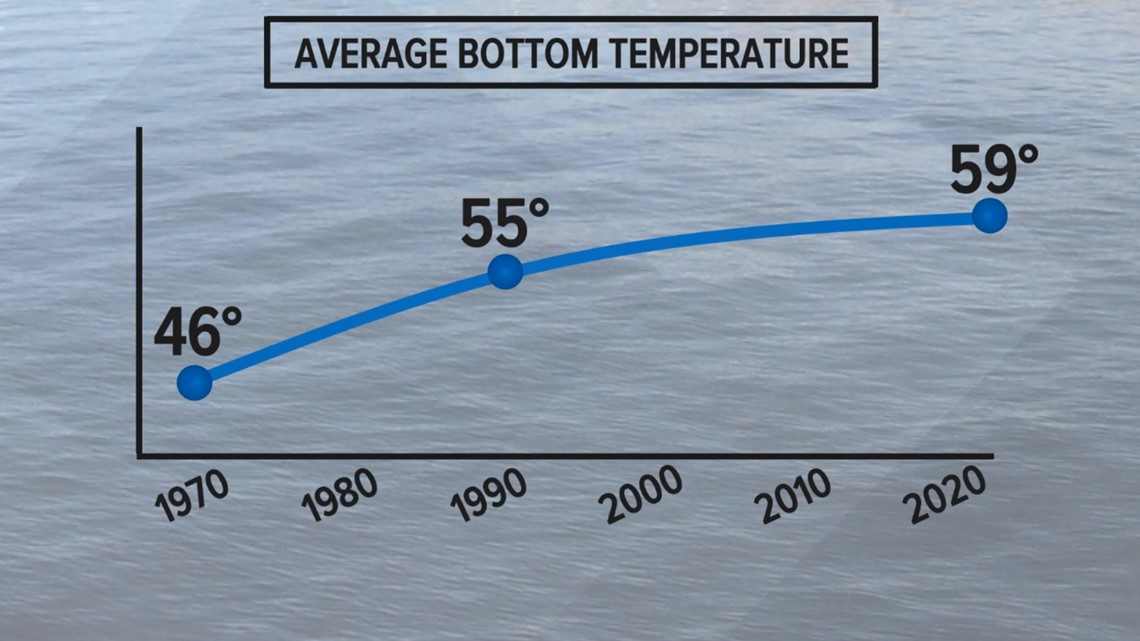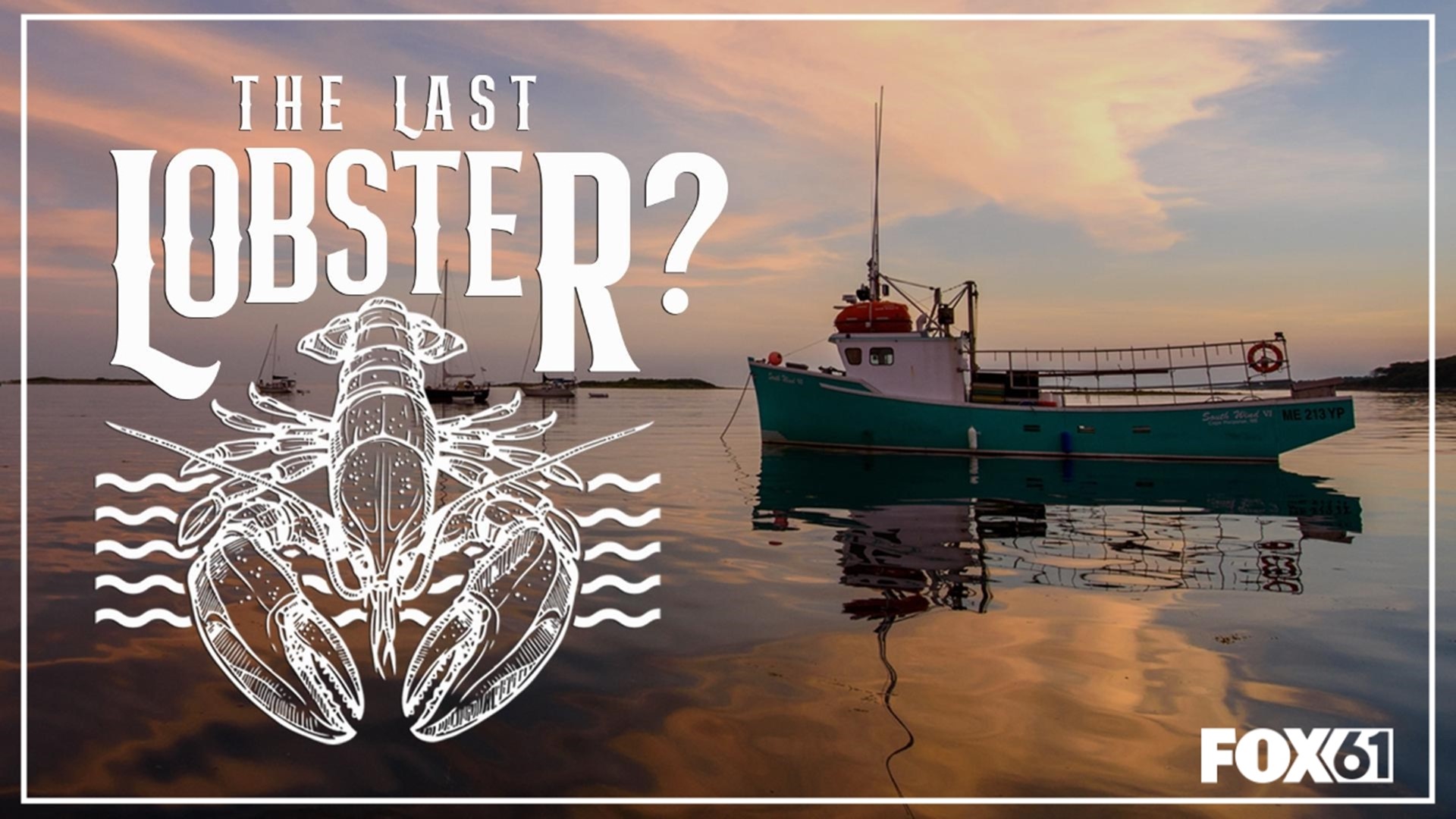STONINGTON, Conn. — As the months begin to warm up, the idea of heading out to a seaside restaurant to enjoy some freshly caught lobster can get the taste buds going.
On Long Island Sound, lobstering is big business – or at least it was for decades. However, in the last 20 years, the population of lobsters – and lobstermen – has nearly vanished.
“I’ve been lobstering before I was driving, and I’m 66, so that’s quite a few years,” said Michael Grimshaw, president of the Southern New England Fisherman’s & Lobstermen’s Association.
Grimshaw has spent more of his life on about off the coast of Stonington. Today, he is one of the last remaining commercial lobstermen in the state.
“I’m shocked to say the least and I’ve tried all my tricks,” Grimshaw said, adding that he never expected working in the industry to become such a challenge.
Commercial lobster landings in Connecticut peaked in 1998, at a high of over 3.7 million pounds per year. In the years since, the drop has been dramatic.


In 2020, the most recent year for data, the Council on Environmental Quality reported landings were approximately 151,000 pounds.
“Lobster was a major cash crop, for lack of a better term, for Long Island Sound for decades,” said Peter Hearn, the executive director for the Council on Environmental Quality. “Around 1998 there were anecdotal reports of decreases in the lobster catch. By 1999, it was pretty dramatic that there had been a fall off.”
RELATED: 'Profound shift' in coastal flooding projected as report finds sea level will rise in next 30 years
Hearn explained that various scientific groups started investigating a possible cause.
Initially, some believed mosquito pesticides, used on both sides of the Sound to combat West Nile Virus in the late 1990s, were to blame.
“It was theorized that perhaps the pesticides also killed off the lobster, or stressed the lobster so that they couldn’t survive,” Hearn said.
In the years since, scientists have not detected pesticides in the lobsters collected. While studying the possible contamination from pesticides, the presence of a parasite or paramoeba was discovered at an increasing rate.
“There was also a higher rate of shell disease, which is also something that lobster can get, but the rate in 1999 and subsequent years was higher than what would be expected,” Hearn said.
Lobsters thrive in cold water, which has become less common in and around Long Island Sound.
Research from the National Oceanic and Atmospheric Administration (NOAA) suggests lobsters can remain healthy in water up to 68 degrees. The longer the lobster population is exposed to warmer water each year, the more vulnerable it becomes.
“The major probability of the decline in lobster is due to the water temperature in the Sound. That water temperature can be stressing the lobsters, causing their greater susceptibility to diseases they normally might resist,” Hearn said.
“They can’t get the oxygen out of the water, they suffocate basically,” Grimshaw explained, as the warmer water can impact their respiratory and immune systems, in addition to increasing the risk for shell disease.
The average annual bottom temperature in Long Island Sound has increased markedly over the last several decades, from 46 degrees in 1970 to 59 degrees in 2020.


“Certainly, in the summer that temperature spikes into the 70s, as you know from going to the beach,” Hearn added, meaning the water now warms above 68 degrees, the upper limit for lobsters, much of the summer.
Three decades ago, there were approximately equal numbers of warm water species and cold water species found in Long Island Sound.
Today, the number of warm-adapted species outpace cold-adapted species by nearly three to one, according to the Council of Environmental Quality.
When asked about climate change, Grimshaw sees no doubt.
“It’s already part of the equation, whether we like it or not,” he said. “The Gulf Stream off here is what they had off the Carolinas years ago. So, I have to believe it, and it’s definitely having an effect on what’s going on for the lobster population, even the fish migration.”
As for overfishing, “well hell, there’s so few lobstermen left that you can’t say they’re really having an impact on anything. I don’t know anybody in this state that can say they are full-time commercial, because they’re not,” Grimshaw said, as the catch just isn’t there.
In the seaside village of Noank, Abbott’s Lobster in the Rough is celebrating its 75th season. In those seven decades, a lot has changed.
Abbott’s opened initially as a lobster pound in 1947. Owner Chelsea Leonard’s grandparents bought it from the Abbotts in 1981.
Today, most of the lobster comes from Maine or Canada, though some still come in from off Point Judith.
“When Abbott’s first opened as a lobster pound, there was a conveyor belt that went right from our dock into the pound,” Leonard said, adding the belt is still used today, to pump seawater in, and filter it through the tanks.
“Hundreds of pounds of lobster were brought right in on this dock daily, which is certainly not the case anymore,” Leonard said.
Complicating the issue for all in the industry this year: inflation.
“The cost is sending us right out of business, bait, fuel, and the cost of everything you use in the lobster industry,” Grimshaw said, adding he is frustrated that diesel, used to fuel the boat, is not included in the state’s gas tax holiday.
Some of the cost is trickling down to the consumer, but Leonard says she’s doing what she can to keep the price as low as possible.
“It’s pretty challenging, when I calculated before we opened what we should be charging for our smallest lobster dinner, which starts at a pound and a quarter, I couldn’t believe the number I was seeing. It was just not something I could put out there on our menu board. So, we are doing everything we can to try to cut costs where we can,” Leonard expressed hope lobster prices will decline a bit in the months ahead.
“We just have to ride it out and see where it goes,” Leonard said.
Ryan Breton is a meteorologist at FOX61 News. He can be reached at rbreton@fox61.com. Follow him on Facebook, Twitter and Instagram.
---
Have a story idea or something on your mind you want to share? We want to hear from you! Email us at newstips@fox61.com
---
HERE ARE MORE WAYS TO GET FOX61 NEWS
Download the FOX61 News APP
iTunes: Click here to download
Google Play: Click here to download
Stream Live on ROKU: Add the channel from the ROKU store or by searching FOX61.
Steam Live on FIRE TV: Search ‘FOX61’ and click ‘Get’ to download.

